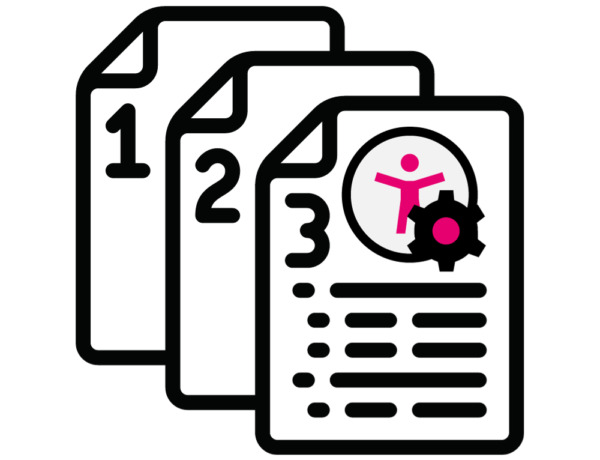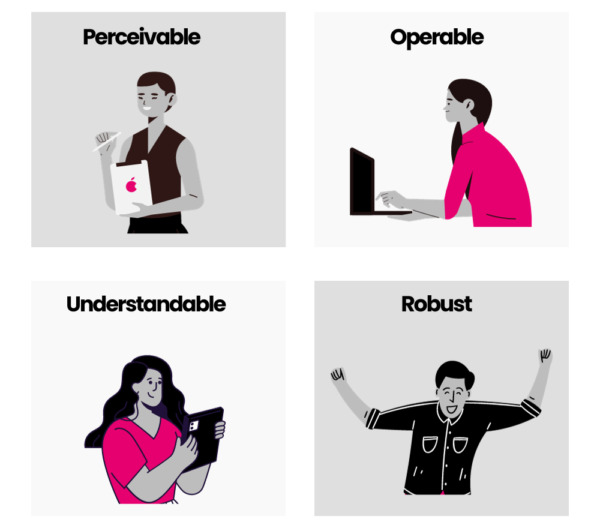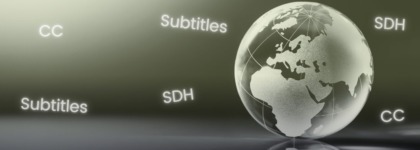Understanding WCAG Guidelines
Updated: October 11, 2023
WCAG 2.0 & Beyond: Modernizing Web Accessibility [Free eBook]
Web Content Accessibility Guidelines (WCAG) remain among the most comprehensive and relevant accessibility standards since their inception over two decades ago. These guidelines offer a structured approach to creating digital content that is both accessible to all web users and compliant with worldwide legal requirements.
You may have recently heard about WCAG during an audit of your organization’s website. Or you may be well-acquainted with WCAG 2.0, but need further information about newer versions. Regardless of your WCAG knowledge, it’s important to have all of the information you need in your pursuit of web accessibility. In this blog, we aim to provide just that: a high-level overview of WCAG guidelines.
Understanding WCAG guidelines will not only allow you and your organization comply with many worldwide web accessibility laws, but will also help you gain a nuanced perspective of how all people–including those with disabilities–use the web. Read on to discover what WCAG is, why its guidelines are important, where it is referenced in the law, and how to learn more using 3Play’s free WCAG resources.
What is WCAG?
Web Content Accessibility Guidelines, or WCAG, is a set of guidelines for making digital content accessible for all users, including those with disabilities. WCAG was developed by the World Wide Web Consortium (W3C) nearly 30 years ago.
WCAG has been continuously developed and updated, and has a few different versions. The two most relevant WCAG standards are WCAG 2.0 and WCAG 2.1. These versions and guidelines are most frequently referenced in laws and legal settlements across the world as the baseline for web accessibility.
In October 2023, W3C published WCAG 2.2. This version is now W3C’s recommendation and is expected to be referenced in future legal cases and legislation.
Overview of WCAG Versions & History
WCAG 1.0
WCAG 1.0 was released in 1999 and uses a set of guidelines. Each guideline has a checkpoint, which are priority 1, 2, or 3.
WCAG 2.0
WCAG 2.0 was released in 2008 and uses four design principles: perceivable, operable, understandable, and robust. Each principle has a guideline, and each guideline has success criteria, which are further categorized into levels A, AA, or AAA. Discover how WCAG 2.0 and its subsequent updates have modernized web accessibility.
WCAG 2.1
WCAG 2.1 was released in 2018 and is backwards compatible with WCAG 2.0. The 2.0 success criteria are the same as in 2.1, but 2.1 has additional guidelines. Learn more about the differences between versions 2.0 and 2.1.
WCAG 2.2
WCAG 2.2 was published in October of 2023. This version is backwards compatible with versions 2.0 and 2.1, with 9 additional guidelines as well as the removal of 4.1.1 Parsing. WCAG 2.2 is W3C’s current recommendation. Keep up with the latest WCAG 2.2 updates, and learn about the changes.
WCAG 3.0
WCAG 3.0 is considered a draft as of September 2023, with no current timeline for publishing. The current draft updates conformance levels to Bronze, Silver, and Gold. This draft also replaces Success Criteria with Outcomes, which is defined by W3C as “verifiable statements that allow testers to reliably determine if the content being evaluated satisfies the user needs identified in the Guideline.” Outcomes are expected to be assigned ratings, which will inform whether or not the website meets Bronze, Silver, or Gold conformance levels. Stay updated on the latest WCAG 3.0 draft, and learn what to expect as further updates are made.
Current WCAG Guidelines, Explained
POUR Principles
WCAG versions 2.0 and later follow four essential principles of accessibility: perceivable, operable, understandable, and robust. These are also referred to as the POUR Principles.
- Perceivable: Information and user interface components must be presentable to users in ways they can perceive.
- Operable: User interface components and navigation must be operable.
- Understandable: Information and the operation of user interface must be understandable.
- Robust: Content must be robust enough that it can be interpreted reliably by a wide variety of user agents, including assistive technologies.
Success Criteria
Under each guideline, success criteria are provided to allow WCAG to be used where requirements and conformance testing are needed. Success criteria have associated levels of conformance (A, AA, or AAA) to help you understand the most critical web accessibility needs. Learn more about Success Criteria conformance for WCAG.
For each guideline and success criteria, WCAG additionally contains techniques for meeting them. Sufficient techniques are considered to be reliable ways to meet success criteria. Advisory techniques are suggested ways to meet success criteria. Advisory techniques may not be sufficient to meet the full requirements of a given success criteria, but can often be helpful to some users who would not be able to access web content otherwise. Learn more about Techniques for WCAG Success Criteria.
Conformance Levels
Each guideline under WCAG 2.0 and beyond has a level of conformance assigned to each success criteria associated with it – Level A, AA, or AAA:
- Level A: The highest priority and usually easiest to achieve.
- Level AA: More comprehensive and often cited as the standard to meet.
- Level AAA: The strictest, most comprehensive accessible design standard, and therefore, the least common level to meet.
As you incorporate WCAG guidelines into your website’s design, use our free checklist to ensure compliance with the necessary success criteria and conformance levels you’re aiming to meet.
WCAG Video Accessibility Guidelines
Video accessibility guidelines are the same in both WCAG versions 2.0 and 2.1.
- Level A: (1.2.2) Captions are provided for all prerecorded audio content in synchronized media, except when the media is a media alternative for text and is clearly labeled as such. (1.2.3) An alternative for time-based media or audio description of the prerecorded video content is provided for synchronized media, except when the media is a media alternative for text and is clearly labeled as such.
- Level AA: In addition to Level A compliance: (1.2.4) Captions are provided for all live audio content in synchronized media. (1.2.5) Audio description is provided for all prerecorded video content in synchronized media.
- Level AAA: In addition to Level A and AA compliance: (1.2.6) Sign language interpretation is provided for all prerecorded audio content in synchronized media. (1.2.7) Where pauses in foreground audio are insufficient to allow audio descriptions to convey the sense of the video, extended audio description is provided for all prerecorded video content in synchronized media.
WCAG’s video accessibility guidelines are among the easiest to implement for a compliant and inclusive web experience. Discover everything you need to know about WCAG in the context of video accessibility.
WCAG & the Law
In the United States, WCAG 2.0 AA or WCAG 2.1 AA is often referenced in legislative updates and documents like “Dear Colleague” letters. These legal callouts have set a precedent in many ADA-based cases, establishing WCAG as the standard for organizations to follow, as it provides the most comprehensive web accessibility guidelines available today.
United States
ADA
WCAG has been increasingly referenced in ADA-based lawsuits and settlements over the past decade. While it is not directly part of ADA legislation yet, the U.S. Department of Justice (DOJ) often points to WCAG guidelines as an example of what standards organizations need to meet for optimal captioning and audio description compliance.
The DOJ recently announced its intent to strengthen web and mobile accessibility under Title II of the ADA. Details of the proposed rule were made available on August 3, 2023. Read the full Notice of Proposed Rulemaking (NPRM) or review the ADA’s Fact Sheet on the NPRM.
The NPRM references WCAG 2.1 Level AA as the technical standard state and local governments would need to follow, but it is important to remember that this proposed rule is just that… for now. The DOJ is soliciting feedback about the proposal through October 3, 2023, and encourages folks to submit their thoughts via regulations.gov or directly mailing comments to the DOJ.
Section 508
Enacted in 1973, the Rehabilitation Act originally addressed disability discrimination for federal entities or organizations receiving federal funding. Two amendments, Sections 504 and 508, broadened the act’s application to online video content.
Section 508 mandates accessibility for electronic media or IT in federal programs or services. While this section doesn’t explicitly extend beyond federal agencies, many states passed laws known as “little 508 laws” that extend the section’s reach to organizations that receive federal funding.
Section 508 requires compliance with WCAG 2.0 Level A and Level AA. Get a detailed overview and analysis of Section 508 and Section 504 of the Rehabilitation Act.
Canada
AODA
The Accessibility for Ontarians with Disabilities Act, otherwise known as the AODA, is an accessibility law based in Ontario, Canada, and it regulates standards across government, public, and private sectors. It was enacted in 2005 to create a barrier-free Ontario by 2025.
Under the AODA, all large private and non-profit organizations with 50 or more employees and all public sector organizations are required to make their websites accessible.
The AODA mandates that web content and online video must conform to WCAG 2.0 AA success criteria with two exceptions: criteria 1.2.4 (live captions) and criteria 1.2.5 (audio descriptions).
Learn more about how the AODA impacts web accessibility.
Worldwide
Around the world, a number of countries have adopted some form of WCAG in their respective accessibility laws. Some, such as Canada and Israel, require conformance with WCAG 2.0 and beyond. Others, like Japan, do not require WCAG, but reference it in legislation or have implemented similar/equivalent guidelines.
Discover how WCAG is being implemented worldwide.
WCAG 2.0 AA remains the primary standard that most organizations should meet. At this time, only if a law explicitly states that web developers have to adapt to a newer WCAG version, are you required to make your content WCAG 2.1 or WCAG 2.2 compliant.
The W3C suggests that any new websites should be created following WCAG 2.2 guidelines since they are more inclusive and provide broader support for users with disabilities. Organizations should move towards meeting WCAG 2.2 to align with the W3C’s suggestions and future legal updates.
Why You Should Implement WCAG Guidelines
WCAG was created to make the digital world more accessible to all. With over 1 billion people in the world with some form of a recognized disability, it’s imperative for organizations to prioritize accessible digital experiences.
By implementing WCAG 2.0, 2.1, or 2.2 Level AA-compliant website features, businesses, public entities, and individuals alike can ensure:
- Accessibility is never an afterthought
- Equal access is provided to all
- Legal risks are minimized
- Market reach expands to billions of users
Committing to web accessibility can help your digital presence thrive. It is not only a social responsibility, but a strategic decision that allows everyone to succeed in the digital age.
Explore WCAG guidelines in greater depth using 3Play’s free resources:
- WCAG 2.0 & Beyond: Modernizing Web Accessibility
- A Practical Guide to WCAG Video Accessibility Requirements
- 12 Things You Need to Know About WCAG 2.1: How it Impacts Your Work & Laws Around the Globe
- Implementing WCAG 2.2 Into Your Digital Strategy
- WCAG Around the Globe
- WCAG 2.0 & 2.1 Compliance Checklist
- Practical First Steps to Achieving Web Accessibility and Reducing Liability Risk
This blog post is written for educational and general information purposes only, and does not constitute specific legal advice. This blog should not be used as a substitute for competent legal advice from a licensed professional attorney in your state.












